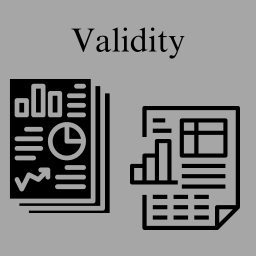Research Instrument to Measure Validity


Whats is Validity
The error is made up of random and systematic components. Maximizing the instrument's reliability helps to reduce the random error associated with the scores (see “Reliability”), although the validity of the instrument helps to minimize systematic error. Reliability is necessary but not a sufficient requirement for validity.
Theoretical Specification
Validity and theoretical specification are inseparable, and the conceptual clarification (see “Instrumentation”) performed in instrument development is the foundation for accurate measurement of the concept. Broadly stated, validity estimates how well the instrument measures what it purports to measure.
Underlying all assessment of validity is the relationship of the data
to the concept of interest. This affects the instrument's ability to
differentiate between groups, predict intervention effects, and describe
characteristics of the target group.
Forms or Types of Validity
Literature usually describes three forms of validity: content,
criteria, and construct. These forms vary in their value to nursing
measurement, and unlike reliability, singular procedures are not established
that lead to one coefficient that gives evidence of instrument validity.
Instead, validity assessment is a creative process of building evidence to support
the accuracy of measurement.
Content Validity
Content validity determines whether the items sampled for inclusion adequately represent the domain of content addressed by the instrument. The assessment of content validity spans the development and testing phases of instrumentation and supersedes formal reliability testing.
Examination of the content focuses on linking the item to the purposes or objective of the instrument, assessing the relevance of each item, and determining if the item pool adequately represents the content. This process is typically done by a panel of experts, which may include professional experts or members of the target population.
Lynn (1986) has provided an excellent overview of the judgment quantification process of having judges assert that each item and the scale itself is content valid. The results of the process produce a content validity index (CVI), which is the most widely used single measure for supporting content validity.
Content
validity should not be confused with the term face validity, which is an
unscientific way of saying the instrument looks as if it measures what it says
it measures. Although content validity is often considered a minor component
for instrument validation, researchers have repeatedly found that precise
attention to this early step has dramatic implications for further testing.
Criteria of Validity
Criterion validity is the extent to which an instrument may be used to measure an individual's present or future standing on a concept through comparison of responses to an established standard.
Examination of the individual's current standing is usually expressed as concurrent criteria validity, although predictive criteria validity refers to the individual's future standing.
It is important to note that rarely can another instrument be
used as a criterion. A true criterion is usually a widely accepted standard of
the concept of interest. Few of these exist within the areas of interest to
nursing.
Construct Validity
Construct validity has become the central type of validity assessment. It is now thought that construct validity really subsumes all other forms. In essence, construct validation is a creative process that rarely achieves completion.
Instead, each piece of evidence adds to or detracts from the support of construct validity, which builds with time and use. Nunnally (1978) proposes three major aspects of construct validity:
(a) specification of the domain of observables
(b) extent to which the observables tend to measure the same concept, which provides a bridge between internal consistency, reliability, and validity
(c) evidence of theoretically proposed relationships between the measured and predicted patterns.
The first aspect is
similar to content validity and is essentially handled through formalized
concept clarification in instrument development. The inclusion of this
specification of the domain under construct validity supports the contention
that construct validity is the primary form, with other types forming subsets
within its boundaries.
The other two aspects of construct validity are examined formally through a series of steps. These steps form a hypothesis testing procedure in which the hypotheses are based on the theoretical underpinnings of the instrument.
Hypotheses can relate to the internal structure of the items on the
instrument. Hypotheses can also refer to the instrument's anticipated
relationship with other concepts. based on a theoretical formulation. The first
set of hypotheses fall into the second aspect of construct validity testing;
the latter relate to the third aspect.
How Examine Hypothesis
Although there are no formalized ways to examine the hypothesis proposed for construct validity testing, some typical approaches have been identified in nursing research. Primarily, the internal structure of an instrument is tested through factor analysis and related factor analytic procedures, such as latent variable modelling.
Factor analysis has become one of the major ways in which nursing researchers examine the construct validity of an instrument. It is important to note that this approach addresses only the second aspect of construct validity testing and in it-self is insufficient to support the validity of an instrument.
Factor analysis simply provides evidence that the underlying factor structure of the instrument is in line with the theoretically determined structure of the construct. The third aspect of construct validation provides an opportunity for more creative approaches to testing.
Hypotheses proposed have to do with the relationship of the concept being measured with other concepts that have established methods of measurement. These hypotheses deal with convergent and discriminate construct validity, subtypes that examine the relationship of the concept under study with similar and dissimilar concepts.
How to Find Similarities and Differences
If data evidence a strong relationship with similar concepts and no relationship with dissimilar concepts, evidence is built for the construct validity of the instrument. Should data not support similarities and differences, several options are possible:
(a) the instrument under construction may not be accurately measuring the concept
(b) the instruments for the other concepts may be faulty
(c) the theory on which the testing was based may be inaccurate.
The multi trait-multi-method (MTMM) matrix has been proposed as a way to formally test convergent and discriminate construct validity.
Another approach to examining the relationship among concepts
involves a known group technique. In this method, the researcher hypothesizes
that the instrument will provide a certain level of data from groups with known
levels on the concept the instrument has been designed to measure.
The above approaches to testing construct validity are only samples
of techniques that can be used. As mentioned, construct validity testing is
creative. Researchers can design unique ways to support the validity of their
instruments. The important point is that whatever is designed must be based on
theory and must be intuitively and logically supported by the investigator.




Give your opinion if have any.